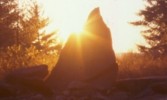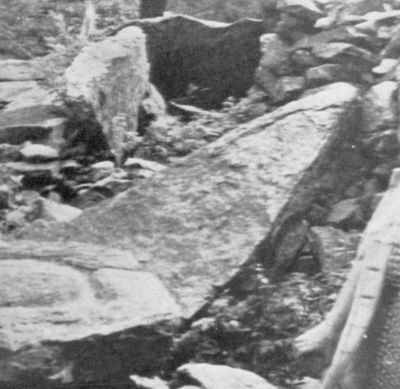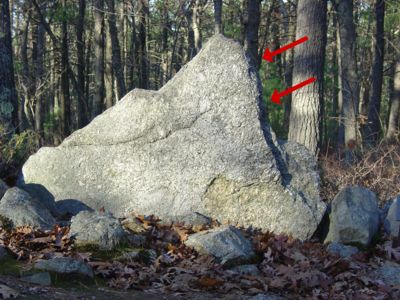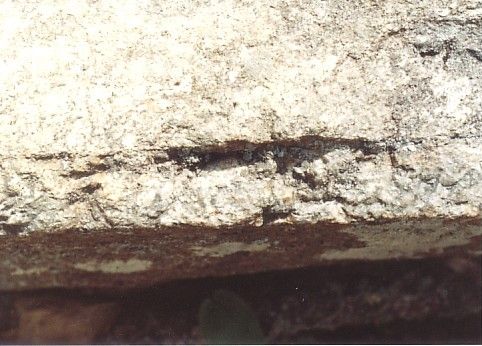

Native American Quarrying
This webpage contains two separate articles on the topic of Native American stone quarrying at the America’s Stonehenge site.
Article 1 – 1982 Excavation of Quarried Stone Slab
Introduction
It has long been recognized that evidence of Native American quarrying is present at the America’s Stonehenge site. Prehistoric Native American quarrying was identified and confirmed by New Hampshire State Archaeologist Gary Hume, Ph.D. and David Stewart-Smith, Master Stonemason at the time who was studying to become an anthropologist / archaeologist.
Excavation of Quarried Slab in an Area Northwest of the Main Complex
David Stewart-Smith, master stonemason and Joseph Auciello, stonemason excavated a quarried stone slab on Mystery Hill under the supervision of Dr. Gary Hume, New Hampshire State Archaeologist. The quarried slab was found in an area with stone outcrops located northwest of the main complex on the summit. The quarried slab measured 13 feet in length, 5 feet wide, and 12 inches thick and weighed an estimated 4 tons. The excavation was reported upon in a short monograph written by David Stewart-Smith titled Ancient and Modern Quarry Techniques (1989).
The slab was first separated from the bedrock by using a wood lever inserted into an existing fissure. (p.7) According to Stewart-Smith, “After moving the stone from the bedrock, the quarrymen levered the face of the stone up about 9 inches and propped it, underneath with a rectangular block of native granite.” (p.4) The excavation report noted the following preparation work done by the quarrymen:
“Most of square 2B-north consists of features directly underneath the dressed stone. Most notably, there was found a concoidal disk with striking platform, about 28 cm by 18 cm, which had been placed under the overhang. The wide end (with striking platform) was jammed deep into the overhang, presumably as a safety-prop. This disk would have had to have been dressed off the face and then placed under the overhang. It had all the qualities of a safety shim. The prop-stone is an angular block which supports the dressed stone, roughly at it’s midriff.” (p.15)
The shaping of the stone slab is described by Stewart-Smith as follows, “At this stage, dressing the ashlar [stone] commenced by striking off a large disk of stone from the underside of the face, creating one, large, initial, concoidal flake, which lies under the stone. The face being narrowed in depth, in this manner, was then worked by striking off smaller flakes. It is apparent that the masons wished to create not only a pointed shape to the stone, but also to sharpen and refine the edge of the face. The smaller dressing-flakes are in evidence under the raised-face of the stone, lying on top of the large initial flake.” (p.4-5) He states that, “The large, initial, dressing flakes were probably struck off using a large `throwing hammer’ weighing 70 to 80 pounds, which was thrown from behind the face to strike off flakes.” (p.9) The smaller flakes were taken off using smaller “cobble-sized hammerstones” (p.12) This technique of removing flakes with hammerstones was referred to as a percussion technique. Stewart-Smith states “The technique is consistent with indigenous stone working techniques used on handtools, and is unique by comparison with colonial quarrying techniques …” (p.5)
Stewart-Smith found, “This form of dressing and hewing is in evidence throughout the site. The peripheral stones [in outer walls] are shaped in this manner and several of the roof slabs [in the chambers] and uprights [vertically placed stone slabs] within the central site have also been quarried and shaped in this manner.” (p.5) In an interview with the New Hampshire Times (4/25/83), Gary Hume, State Archaeologist at the time of the excavation, concluded, “The bulk of the stones at Mystery Hill were quarried by hand, using stone tools. ‘The marks are unmistakable,’ says Gary Hume, archaeologist for the state historic preservation office.” In another interview with New Hampshire Crossroads, Dr. Hume “admitted the possibility of some great age to the site.” He speculated the Native Americans used the site for ritual or ceremonial purposes (p.11).
The research and excavation by Gary Hume and David Stewart-Smith confirmed the stone was quarried by hand using stone tools. They stated the large stone slab had been pried loose from the bedrock, moved, thinned, safely propped up and specifically shaped to a point. David Stewart-Smith noted some of the roofs slabs in the chambers were pre-historic quarried stones. He also pointed out numerous uprights (standing stones) found on site were quarried and shaped. Some of these standing stones have pointed tops. The pointed top is one of several shapes found on site (See Standing Stones Article and Spirit Portal Article for other shapes).
The Native Americans quarrying the stones had to have had a purpose given the excavated stone was not only quarried from the bedrock but it was thinned to a desired thickness and then shaped to a desired shape. The shape with its pointed top was not suitable for a structural building stone like the roof slabs. This suggests the shaped stone had ritual, ceremonial or symbolic purpose.
 |
A 1940’s photo from Goodwin’s book showing a shape standing stone near the large grooved stone.
It is similar in size and shape to the one investigated in the excavation.
(Click on photo to view larger image)
 |
The summer solstice sunset standing stone has evidence of being worked by the percussion flaking method (red arrows).
(Click on photo to view larger image)
Article 2 – Other Evidence of Native American Quarrying
The earliest evidence of quarrying at the site is C-14 dated to 2995 B.P. +/- 180. Two excavations outside the Collapsed Chamber’s north wall uncovered an occupation layer. The layer contained a quarried slab, charcoal, burned stone spalls, a broken pick, a hammer stone, and a scraper (Glynn 1967, 55-57; Whittall 1969b, 50-54; Whittall 1977a, 22-28.) In another excavation, adjacent to the ditch drain outside of the low walled enclosure, charcoal was recovered in association with quarrying of the surface bedrock. The charcoal was C-14 dated to 2120 B.P. +/- 95 (Whittall 1971, 19-20.) The evidence from these excavations indicates that the Native Americans were using fire for the purpose of quarrying the bedrock. The fire was used to heat the rock and then hammer stones were used to chip the fire damaged rock away. A third example of quarried bedrock is found along the edge of the bedrock on the northwest side of the Tall Wall. Chipping is evident along the edge of the fracture where the slab was removed. The slab removed from this location was moved a few feet north and raised into position as a roof slab for the Sundeck [chamber] against the Ramp. This quarrying took place circa 1400 B.P. (The storage chamber was built after the Oracle Chamber which is C-14 dated 1430 B.P.)
 |
Chipped Edge Where Slab was Removed for the Sundeck Chamber
Stone slabs for the structures were quarried both within the ceremonial area and outside of it. The Native Americans exhibited a strong preference for using stone slabs quarried within the ceremonial area. The Large Grooved Stone was quarried from the bedrock below the current wooden viewing platform, the Oracle Chamber was built with stone blocks quarried from its north-south room, the large slab at the Abandoned Chamber was from the adjacent bedrock, and so forth. Furthermore, the Native Americas quarried stone next to their ceremonial earth ditch drain. Great care was needed to avoid damaging the ditch drain.
What was the purpose of quarrying stone within the ceremonial area rather than taking greater advantage of exposed bedrock outside of the area? The first reason is practical. They minimized the distance the quarried stone had to be moved. However, this motive doesn’t fully account for quarrying so close to a sacred ceremonial feature: the ditch drain. The one motive that does account for this is they considered the stone within the ceremonial area to be sacred.
The references for all the articles on this website are consolidated on the Bibliography page.
